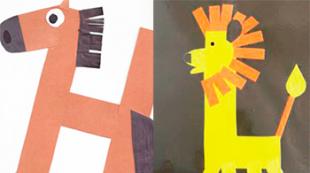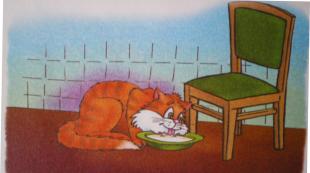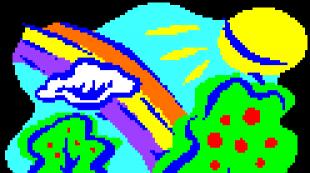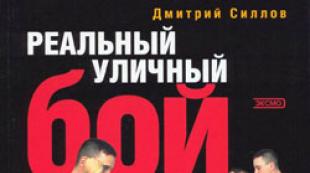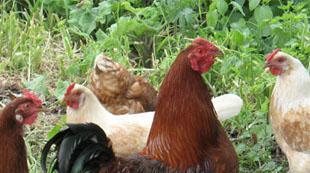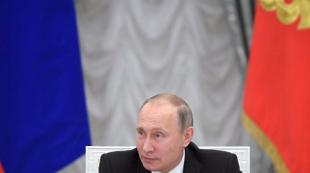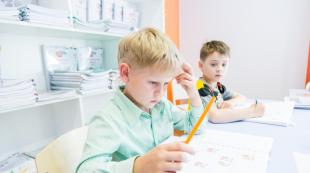Fable of the Krylov monkey and cheating glasses. Physics around us is educational and terribly exciting ;-)
The monkey has become weak in his eyes in old age;
And she heard people
That this evil is not yet so big of a hand:
You just need to get glasses.
She got half a dozen glasses for herself;
Twirls his glasses this way and that:
Now he will press them to the crown, then he will string them on the tail,
Now he sniffs them, then he licks them;
The glasses don't work at all.
"Ugh abyss! - she says, - and that fool,
Who listens to all human lies:
Everything about Points was just lied to me;
And there is no use for a hair in them.
The monkey is here with annoyance and sadness
O stone so sufficed them,
That only the spray sparkled.
___________
Unfortunately, the same thing happens to people:
No matter how useful a thing is, without knowing the price,
The ignoramus about her tends to get worse all the time;
And if the ignorant is more knowledgeable,
So he still chases her.
Analysis / morality of the fable "The Monkey and Glasses" by Krylov
The fable "The Monkey and Glasses" is one of the most famous works of Ivan Andreevich Krylov, which is invariably included in the school curriculum.
The fable was written in 1815. Its author at that moment was 46 years old, he works in the Public Library of St. Petersburg. In literary terms, the writer almost completely switched to fables. The 1815 collection was published with illustrations. The fable was composed in the size of a free iambic, typical for I. Krylov. The activity of one actor (Monkeys) is blocked by the equanimity of the other (Points). A small narrow-nosed monkey "in old age" became blind. In captivity, she could reach a very advanced age - thirty or even forty years. “Weak eyes”: she began to see badly, which means she got into a mess. “I heard from people”: she lived with someone (most likely in a noble house) almost as a family member. "Evil of a small hand": an idiom meaning that the matter is fixable. "Points from half a dozen": six pieces. "I got it": I simply pulled it off. “Twirls this way and that”: an example of an outdated stress in a word. "Temya": the area of the head closer to the back of the head. Then a series of colorful prefixed verbs connected by enumerative gradation: press, sniff, string, lick. "They don't work at all." Glasses do not "come to life" to tell her their secrets, or rather, the main one is the art of wearing them. “Pah the abyss!”: the monkey scolds. People also get it for “lies”, she even calls herself a “fool” for listening to a fable about the benefits of glasses. “To the hair”: another idiom by I. Krylov, meaning “not by a hair, not at all.” “Enough about the stone”: an angry Monkey ran out into the yard with glasses, where she shattered them so that “the spray sparkled” (this is also a metaphor). "Knower": having a name and weight in society. Morality follows: the ignoramus is not for the future, without understanding, he scolds even very good things. If something didn’t work out for one, it’s not a fact that it won’t work out for another. The theme of knowledge, enlightenment falling into the hands of ignoramuses is also played up. Perhaps there is a subtext of the perception of innovations by different generations (the monkey was elderly). Finally, the availability of points to the heroine did not benefit. Vocabulary is colloquial, interspersed with expressive, sometimes obsolete, turns. Changes in rhythm and intonation are facilitated by the wide possibilities of multi-foot iambic.
In "The Monkey and Glasses" I. Krylov presents ignorance and complacency to the reader's judgment.
The fable “The Monkey and Glasses” by Krylov will tell about the stupid Monkey, who broke good glasses because of his own ignorance.
Read the text of the fable:
The monkey has become weak in his eyes in old age;
And she heard people
That this evil is not yet so big of a hand:
You just need to get glasses.
She got half a dozen glasses for herself;
Twirls his glasses this way and that:
Now he will press them to the crown, then he will string them on the tail,
Now he sniffs them, then he licks them;
The glasses don't work at all.
“Pah the abyss!” she says, “and that fool
Who listens to all human lies:
Everything about Points was just lied to me;
And there is no use for a hair in them.
The monkey is here with annoyance and sadness
O stone so sufficed them,
That only the spray sparkled.
Unfortunately, the same thing happens to people:
No matter how useful a thing is, without knowing the price,
The ignoramus about her tends to get worse all the time;
And if the ignorant is more knowledgeable,
So he still chases her.
Moral of the fable Monkey and glasses:
The moral of the fable is that often the ignorant, not bothering to inquire about the value of any object, begin to speak badly about it. This happens in real life too. For example, people who do not appreciate scientific and technological progress tend to speak negatively about the achievements of mankind, forgetting that it is thanks to science that a person is spared exhausting physical labor, numerous diseases, etc. If a person does not know how to use any thing is not a reason to speak badly about it, the fabulist teaches.
Monkey and glasses drawing
Fable monkey and glasses read text
The monkey has become weak in his eyes in old age;
And she heard people
That this evil is not yet so big of a hand:
You just need to get glasses.
She got half a dozen glasses for herself;
Twirls his glasses this way and that:
Now he will press them to the crown, then he will string them on the tail,
Now he sniffs them, then he licks them;
The glasses don't work at all.
“Pah the abyss!” she says, “and that fool
Who listens to all human lies:
Everything about Points was just lied to me;
And there is no use for a hair in them.
The monkey is here with annoyance and sadness
O stone so sufficed them,
That only the spray sparkled.
And if the ignorant is more knowledgeable,
So he still chases her.
Moral of Ivan Krylov's fable - Monkey and glasses
Unfortunately, the same thing happens to people:
No matter how useful a thing is, without knowing the price,
The ignoramus about her tends to get worse all the time;
And if the ignorant is more knowledgeable,
So he still chases her.
Morality in your own words, the main idea and meaning of Krylov's fable
Under the glasses, Krylov showed knowledge that very often breaks down on the unwillingness to learn, improve, break through, try. Hence the result: the silly monkey was left with nothing.
Analysis of the fable Monkey and glasses, the main characters of the fable
"The Monkey and the Glasses" is an easy, accurate work, and most importantly, it is a necessary guide to the right actions in life. Krylovsky's humor is striking (glasses are sniffed and licked by a monkey, put on the tail) and prudence in the form of morality at the end of the fable. Ivan Andreevich once again brought a person with a serious flaw onto the stage in order to help many others eradicate a similar flaw in themselves.
About the fable
"The Monkey and Glasses" is a fable for all time. In it, Krylov quickly, briefly and very accurately revealed the inner essence of a stupid, uneducated, infantile person. The 21st century is the century of new brilliant inventions that are impossible without the necessary knowledge, perseverance, the ability to think, analyze, compare. Reading and studying the fable "The Monkey and Glasses" at school is an initial guide to action - to study long and patiently, diligently and with pleasure, so that later, in adulthood, give people new ideas and promote them to life.
From under the thin pen of Krylov, a fable about a monkey and half a dozen glasses came out in 1812. It was the year of the war with the French. The allegorical nature of the fable helped the writer to talk about ignorant and empty people who scold science and knowledge and do not benefit the state. If at that time there were fewer such "monkeys", then the outcome of the war would have been different. The fabulist, laughing and ironically, raises in his fable the great human problem of stupidity and idleness.
Monkey is the main character
The main character of the fable is a monkey. She is fidgety, impatient, superficial. Hearing about the benefits of glasses, she immediately tried to correct her weakened vision with them. But how to do this - did not specify. They say about such "comrades": "tap-blunder" or "heard a ringing but does not know where he is." You can understand the monkey's haste - she rather wants to see the world with healthy eyes. But haste and ignorance have never benefited anyone, as well as ardor and anger. Was it worth it to smash all the glasses to smithereens, then to remain visually impaired and unsatisfied?
Popular expressions that went from the fable Monkey and glasses
- That fool who listens to all the people's lies
- Monkey old age became weak eyes
Listen to Ivan Krylov's Fable Monkey and Glasses
Our job is to learn and learn
try to accumulate as much knowledge as possible,
because serious social movements are there,
where knowledge, and the happiness of the future of mankind is only in knowledge.
Anton Pavlovich Chekhov
Anton Pavlovich Chekhov(01/17/1860–07/02/1904) - a great Russian writer, talented playwright, academician, doctor by profession.
Fable "Monkey and Glasses" by Ivan Andreevich Krylov
Today on the program fable "Monkey and Glasses" famous Russian fabulist Ivan Andreevich Krylov; chapter from the elementary textbook of physics, edited by Academician G.S. Lansberg - "The eye as an optical system"; drawings to filmstrip "Fables of grandfather Krylov" Repkin and great with answers ;-)
MONKEY AND GLASSES
The monkey has become weak in his eyes in old age;
And she heard people
That this evil is not yet so big:
You just need to get glasses.
She got half a dozen glasses for herself;
Twirls his glasses this way and that:
Now he will press them to the crown, then he will string them on the tail,
Now he sniffs them, then he licks them;
The glasses don't work at all.
"Pah the abyss!" she says, “and that fool
Who listens to all human lies:
Everything about Points was just lied to me;
And there is no use for a hair in them.
The monkey is here with annoyance and sadness
O stone so sufficed them,
That only the spray sparkled.
──────────
Unfortunately, the same thing happens to people:
No matter how useful a thing is, without knowing its price,
The ignoramus about her tends to get worse;
And if the ignorant is more knowledgeable,
So he keeps pushing her.
1815
Ivan Andreevich Krylov(02/13/1769 - 11/21/1844) - Russian publicist, poet, fabulist, publisher of satirical and educational magazines. He is best known as the author of 236 fables, collected in nine lifetime collections (published from 1809 to 1843). Along with the fact that most of the plots of Krylov's fables are original, some of them go back to the fables of La Fontaine (who, in turn, borrowed them from Aesop, Phaedrus and Babrius).
Eggink Ivan Egorovich(1784-1867) - Russian painter, portrait painter, author of paintings of the historical genre. Academician of the Imperial Academy of Arts in St. Petersburg.
Fable "Monkey and Glasses"
performed by Igor Ilyinsky
Unfortunately, audio tag not supported by your browser :-(
Igor Vladimirovich Ilyinsky(1901-1987) - Soviet actor, theater and film director, master of the artistic word (reader). Hero of Socialist Labor. People's Artist of the USSR. Laureate of the Lenin Prize and three Stalin Prizes of the first degree.
For the curious:
Glasses are first mentioned in documents from 1289. The inventors of eyeglasses are considered to be a Venetian glass blower. Salvino Armati and a Dominican monk Alessandro Spine. There is a funny legend according to which the Venetian glass blower Armati, pouring liquid glass into a mold, spilled some of it on the table. When the glass froze, a very interesting piece of glass turned out - a lens, flat on one side and convex on the other. Armati drew attention to the fact that this same piece of glass can enlarge objects.
So the lenses for the far-sighted eye were born ;-)
Laptev Alexey Mikhailovich(04/10/1905 - 01/15/1965) - Soviet graphic artist and book illustrator, poet. Corresponding Member of the Academy of Arts of the USSR, Honored Art Worker of the RSFSR.
Elementary textbook of physics
under the editorship of Academician G.S. Ladsberg
THE EYE AS AN OPTICAL SYSTEM
The human eye is approximately spherical in shape; its diameter (on average) is 2.5 cm; the eye is surrounded on the outside by three shells.
Outer hard and durable shell 1
called sclera or protein shell, protects the inside of the eye from mechanical damage. The sclera at the front of the eye is transparent and is called cornea or cornea 2
; on the rest of the eyes, it is opaque, has a white color and is called protein.
Adjacent to the sclera from the inside choroid 3
, consisting of a complex plexus of blood vessels that feed the eye. This second shell in front of the eye passes into iris, colored in different people in different colors.
The iris has a hole in the middle called pupil 4
. The iris is able to deform and thus change the diameter of the pupil. This change occurs reflexively (without the participation of consciousness) depending on the amount of light entering the eye; in bright light, the pupil diameter is 2 mm, in low light it reaches 8 mm.
Fig 1: Schematic section of the human eye

1 - protein coat; 2 - cornea; 3 - choroid; 4 - pupil; 5 - lens; 6 - retina; 7 - optic nerve; 8 - vitreous body; 9 - front camera
On the inner surface of the choroid is located retina, or retina 6 . It covers the entire bottom of the eye, except for its anterior part. Behind through the shell enters optic nerve 7 that connects the eye to the brain. The retina consists mainly of branches of the optic nerve fibers and their endings and forms light-sensitive surface of the eye.
The space between the cornea and the iris is called front camera 9 ; it is filled with chamber moisture. Inside the eye, just behind the pupil, is lens 5 , which is a transparent elastic body with biconvex lens shape. The curvature of the surfaces of the lens can change as a result of the action of the muscle surrounding it from all sides. By changing the curvature of the surfaces of the lens, the image of objects lying at different distances is brought exactly to the surface of the sensitive layer of the retina; this process is called accommodation. The entire cavity of the eye behind the lens is filled with a transparent gelatinous fluid, forming vitreous body 8 .
In terms of its structure, the eye as an optical system is similar to a camera. The role of the lens is performed by the lens together with the refractive medium of the anterior chamber and the vitreous body. The image is obtained on the light-sensitive surface of the retina. Focusing the image is carried out by accommodation. Finally, the pupil plays the role of a diaphragm that changes in diameter.
The ability of the eye to accommodate makes it possible to obtain sharp images of objects at different distances on the retina. A normal eye in a calm state, i.e. without any effort of accommodation, gives a clear image of distant objects (for example, stars) on the retina. With the help of muscular effort, which increases the curvature of the lens and, consequently, reduces its focal length, the eye aims at the desired distance. The smallest distance at which a normal eye can clearly see objects varies with age from 10 cm (under 20 years of age) to 22 cm (about 40 years of age). At an older age, the ability of the eye to accommodate still decreases: the smallest distance reaches 30 cm or more - age-related farsightedness.
Rice. 2: Myopia and hyperopia of the eye

In a normal eye, the back focus is on the retina (a);
myopia of the eye (b) is corrected with a diverging lens (c);
farsightedness (d) - with the help of a converging lens (d)
Not everyone's eyes are normal. Quite often, the back focus of the eye in a calm state is not on the retina itself. (as in a normal eye; Fig. 2a) but on either side of it. If the focus of the eye at rest lies within the eye in front of the retina (Fig. 2b), then the eye is called shortsighted. Such an eye cannot clearly see distant objects, since muscle tension during accommodation further moves the focus away from the retina. To correct myopia, the eyes must be equipped with diverging lens glasses (Fig. 2c).
In a far-sighted eye, the focus in a calm state of the eye is behind the retina (Fig. 2d). farsighted the eye refracts weaker than normal. In order to see even very distant objects, the far-sighted eye must make an effort; for the vision of nearby objects, the accommodative ability of the eye is no longer sufficient. Therefore, to correct farsightedness glasses with converging lenses are used (Fig. 2e), bringing the focus of the eye in a calm state to the retina.
We emerge from my adorable physics ;-) and plunge into amazing illustrations for the fable "Monkey and Glasses" performed by the Soviet animator Pyotr Petrovich Repkin. Your attention is a luxurious eight drawings for the Soviet filmstrip "Fables of grandfather Krylov".
FABLE "MONKEY AND GLASSES" by IVAN ANDREYEVICH KRYLOV
"Fables of grandfather Krylov"
Filmstrip studio production, 1986
Artist P. Repkin
Repkin Petr Petrovich(1915–1995) – Soviet production designer for animated films. Since 1944 he has been an animator at the Soyuzmultfilm studio. He worked at the Filmstrip studio for all the years of its existence - from 1935 to 1993. Honored Art Worker. Member of the Union of Artists of the USSR. Member of the Union of Cinematographers of the USSR.
The final chord of the article is dedicated to true connoisseurs of physics and those who are just trying to understand and love it ;-)
For your attention wonderful five high-quality problems in physics and portraits of elderly gentlemen with glasses by the British painter Charles Spenceley.
Charles Spenceley
Qualitative tasks in physics
Authors: Demkovich V.P., Demkovich L.P.
Task #1
Take glasses and, without using any foreign objects, determine whether they are intended for a near-sighted or far-sighted eye?
Answer: It is necessary to carefully touch the glasses with your fingers; if in the middle the glass is thicker than at the edges, then we have a converging lens in our hands - for a far-sighted eye, and if in the middle the glass is thinner than at the edges, then we have a diverging lens in our hands - for a short-sighted eye.
Rice. 3: Converging and diverging lenses

Converging lenses: biconvex lens (a); plano-convex lens (b); positive meniscus (c).
Divergent lenses: biconcave lens (d); plano-concave lens (e); -negative meniscus (e).
note that convex-concave lens(c,e)
is called a meniscus and can be collecting (thickens towards the middle - a positive meniscus (c) or scattering (thickens towards the edges - a negative meniscus (e).
Charles Spenceley(Charles Spencelayh; 10/27/1865 - 06/25/1958) - British genre painter, portrait painter.
Task #2
Take glasses and, without touching the glasses with your fingers, determine whether they are intended for a near-sighted or far-sighted eye?
Answer: You need to look through glasses like through a magnifying glass; if increased - for far-sighted, and if reduced - for short-sighted.
Charles Spenceley(Charles Spencelayh; 10/27/1865 - 06/25/1958) - British genre painter, portrait painter.
Task #3
Why can far-sighted people, having lost their glasses, read through a small hole (3–5 mm) made in paper? Check for yourself the property of a small hole, after placing your eyes very close to the printed text.
Answer: In this case, only the central rays pass into the pupil, which do not give a blurry image.
But what happens if you try to see a fairly distant text (a sign on a store) through this small hole, after placing your eyes very close to the hole?
Checking ;-)
Task #4
The microscope is set for a normal eye. Where should a nearsighted and farsighted person move the tube (up, down)?
Answer: Nearsighted down, farsighted up.
Task #5
How should people who use glasses work with a microscope: look into the eyepiece through glasses or without them?
Answer: Both options are possible.
Charles Spenceley(Charles Spencelayh; 10/27/1865 - 06/25/1958) - British genre painter, portrait painter.
I wish you a pleasant and useful reading, as well as success
in independent solution of high-quality problems in physics!
The materials of this article will be useful to apply not only at the lessons of physics and fiction, but also in extracurricular activities.
I hope that the solution of the problems in physics proposed in the article will not only help to arouse interest in the subject among schoolchildren, but also expand their knowledge and cultural horizons ;-)
LEARN PHYSICS BY READING THE CLASSICS
Dear readers of the green pages, I am glad to inform you about the publication of my book - "Learn physics by reading the classics".
However ... "my book", this is still immodestly said :-) First of all ... this is a divine classic of fiction: A.P. Chekhov, I.A. Bunin, K.G. Paustovsky, A.N. Tolstoy... and only then my informative comments regarding physics and astronomy ... Thank you very much Tatyana Borisovna Dergach- Leading editor of the publishing house "Avanta" ( AST Publishing House LLC), for the well-coordinated and pleasant in all respects work on the book.
The book is dedicated to my parents: mother - Lebedeva Lidia Stepanovna and dad- Lebedev Valery Vladimirovich, who back in 1984 categorically insisted that :-) that I try my hand at the entrance exams in ROFMSH…
Learn physics by reading the classics

I wish you a pleasant and useful reading!
Egor
Great article. BRAVO! With such illustrative material, teaching physics is a pleasure))) The five high-quality problems in physics are selected with soul and knowledge of the matter.
Igor Ilyinsky is a unique master of the artistic word! I listened to all the fables performed by him on your site. Thank you. Got great pleasure.
I was somewhat surprised that satire was bypassed this time. But this is fixable.
Grandfather Krylov's fable "The Monkey and Glasses" is remarkable primarily because the main idea in it is expressed not only in morality, the main irony is in the text. An attentive reader will easily understand that the Monkey plays the role of an ignoramus, and glasses are directly associated with science. People-Monkeys, who do not understand anything in science, far-sighted and vigilant, like glasses, often with their ignorance will only make everyone around laugh. Ignorance, especially high-ranking officials, affects everyone around. The irony is that officials cannot hide their short-sightedness and outright short-sightedness. The whole country laughs at such officials. WHILE only laughs !!!)))
Evgenich
Cool! The schematic section of the human eye was terrifying!!!
Physics is awesome! Five points!!!
green page reader
Awesome! You are a talent! This is rare these days!
Sincere love for physics, fiction and children!
THANK YOU!!!
PHYSICS AROUND US
Informative and very entertaining ;-)
§
Three stages of recognition of scientific truth: the first - "this is absurd", the second - "there is something in this", the third - "it is well known". Ernest Rutherford
I invite readers of the green pages to go on an exciting journey through the pages of an amazing book "Physics and Music" Soviet journalist, popularizer of science Gleb Borisovich Anfilov ...
§ Physics and music: graceful forms of violin and guitar…
Music forms the middle between thought and appearance. Heinrich Heine
Today on the agenda we have a very simple, but at the same time very intricate question ;-) Why do violins, guitars, mandolins, dombras have an oblong shape?
§
To your attention are riddles and proverbs about snow, the inimitable poetry of winter performed by Ivan Bunin and Robert Rozhdestvensky, masterpieces of world art and my adored physics!
§ Physics around us: Photo album "Frost patterns on the windows"
To your attention, photographs accompanied by entertaining and informative material - an article from the popular scientific physical and mathematical journal "Kvant": "About frosty patterns and scratches on glass"(1990, No. 12).
PHYSICS AND ART LITERATURE
Qualitative tasks in physics
§ Physics and Fiction: Optics
The bewitching magic of moonlight...
Scientists are the same dreamers and artists; they are not free over their ideas; they can work well, work for a long time only on that to which their thought lies, to which their feeling leads. In them ideas change; the most impossible, often extravagant ones appear; they swarm, whirl, merge, shimmer. And among such ideas they live and for such ideas they work. Vladimir Ivanovich Vernadsky
§ Physics and Fiction: Optics
Divination with mirrors for Christmas time ...
The feeling of mystery is the most beautiful experience we have. It is this feeling that stands at the cradle of true art and true science. Albert Einstein
§ Physics and fiction: Optics (N.V. Gogol and H.K. Andersen)
There is hardly any higher pleasure than the pleasure of creating.
Nikolai Vasilyevich Gogol
Qualitative problems in physics by Nikolai Vasilyevich Gogol and Hans Christian Andersen ;-) Integration: World fiction and painting.
§ Physics and Fiction: Optics
Fable "Mirror and Monkey" by Ivan Andreevich Krylov
People who neglect knowledge stand facing the wall.
Sayings of Chinese wisdom
§ Physics and fiction: Mechanics
Fable "Swan, Pike and Cancer" by Ivan Andreevich Krylov
The man who hopes without teaching to distinguish between the useful and the harmful is reckless.
Socrates
§ Physics and fiction: Sound vibrations
Fable "Quartet" by Ivan Andreevich Krylov
It's sad to listen to music without words,
but it's even sadder to listen to music without music... Mark Twain
§ Physics and fiction: Mechanical waves - sound
A feature of a living mind is that it needs only a little to see and hear so that it can then think for a long time and understand a lot. Giordano Bruno
§ Physics and fiction
poetry collection for true connoisseurs of science and art
Science without literature is soulless and crude; literature without science is empty, for the essence of literature is knowledge. Anatole France
§ Physics and fiction (Vladimir Galaktionovich Korolenko)
Inspiration is not the exclusive property of the artist: without it, the scientist will not go far, without it even the craftsman will not do much, because it is everywhere, in every deed, in every labor. Vissarion Grigorievich Belinsky
§ Physics and fiction (Alexander Ivanovich Kuprin)
Man is born for great joy, for unceasing creativity, in which he is a god, for a wide, free, unrestricted love for everything; to a tree, to the sky, to a man, to a dog, to a sweet, meek, beautiful earth, ah, especially to the earth with its blissful motherhood, with its mornings and nights, with its beautiful daily miracles. Alexander Ivanovich Kuprin
§ Physics and fiction (Konstantin Georgievich Paustovsky)
Knowledge is organically linked to human imagination. This seemingly paradoxical law can be expressed as follows: the power of imagination increases with the growth of knowledge. Konstantin Georgievich Paustovsky
§ Physics and fiction (Ivan Alekseevich Bunin)
Science and art are as closely intertwined as the lungs and the heart, so that if one organ is perverted, the other cannot function correctly.
Lev Nikolayevich Tolstoy
§ Physics and fiction (Johann Wolfgang Goethe "Faust")
Goethe represents, perhaps, the only example in the history of human thought of combining a great poet, a deep thinker and an outstanding scientist in one person. Kliment Arkadyevich Timiryazev
§ Physics and fiction (Mine Reed "The Headless Horseman")
The aim of scientific pursuits should be to direct the mind in such a way that it makes firm and true judgments about all the subjects encountered.
Rene Descartes
I bring to your attention the integrated qualitative tasks in physics from the famous English captain Mine Reed.
§ Physics and fiction: Thermal phenomena
Beauty is the radiance of truth. Plato
To your attention 20 high-quality tasks in physics (two cards of ten tasks each) and ... in the subject :-) a small gallery: “Fog in painting”.
BIOPHYSICS IN PHYSICS LESSONS
§ Biophysics: The Sound of Insects
Fable "Dragonfly and Ant" by Ivan Andreevich Krylov
The essence of Krylov's fable "The Dragonfly and the Ant", it would seem, lies on the surface - "Who does not work, he does not eat", but in the realities of modern Russia everything turns out topsy-turvy :-(
§ Biophysics: Legs, tails... the main thing... - ears!
Cognitive material dedicated to the adaptation of animals to different temperatures on the example of representatives of the canine family - fennec, fox, arctic fox ...
§ Biophysics: Echoes in the Wildlife World - Bat Sonars
My goal is to free the mind from tenacious superstitions. Titus Lucretius Kar
Why don't bats fly into obstacles even in total darkness?
Cognitive biophysical material dedicated to amazing animals - bats, undeservedly offended by the human race ...
§ Biophysics: Secrets of the Dolphin
An entertaining and educational biophysical material that lifts the veil of mystery over some of the features of the organization of dolphins: self-adjusting skin and unsurpassed sonar ...
§ Biophysics: Jet Propulsion in Wildlife
According to the principle of jet propulsion in wildlife, a number of animals move, for example, jellyfish, scallops, dragonfly larvae, squids, octopuses, cuttlefish ...
Let's take a closer look at some of them ;-)
§ Biophysics: Why do cat eyes glow?
"Physical surprise and interesting" ;-)
Why do dogs, cats and other animals with good night vision have eyes that glow in the dark?
BOXES OF QUALITATIVE TASKS IN PHYSICS
§ Physics and Geography of Kazakhstan
Joint project: OFRO "BEST" and Technical Lyceum No. 165 (Alma-Ata)
§ Yak-3 - the lightest fighter of World War II
Special thematic issue of green pages.
For your attention, five questions and tasks dedicated to the legendary Soviet fighter Yak-3… + a thematic selection of 10 puzzles.
“Only in a cheerful hot impulse, in passionate love for his native country, courage and energy will be born VICTORY. And not only and not so much in a separate impulse, but in the stubborn mobilization of all forces, in that constant burning that slowly and steadily moves mountains, opens up unknown depths and brings them to sunny clarity ... " Mikhail Vasilievich Lomonosov
§ Box of quality problems in physics "collective hodgepodge" :-)
Throwing pebbles into the water, look at the circles they form, otherwise such a throwing will be empty fun. Kozma Prutkov
The box consists of four thematic blocks: 1) Brownian motion. Diffusion; 2) Atmospheric pressure; 3) Properties of the liquid. Archimedean force; 4) Thermal phenomena.
§ Box of quality problems in physics: The structure of matter, diffusion
The work of a poet, the dialectics of a philosopher, the art of a researcher - these are the materials that make up a great scientist. Kliment Arkadyevich Timiryazev
§ Box of quality problems in physics:
Elements of statics: balance of bodies, moment of force, simple mechanisms
Strive to comprehend science ever deeper, languish with eternal thirst for knowledge. Only the first knowledge will shine on you, you will know: there is no limit to knowledge. Ferdowsi
§ Box of quality problems in physics: Inertia
Dedicated to Alexander Arsenievich Chernobay
,
director ROFMSH(Alma-Ata, ROFMSH, 1984–1987)
Let no one think that Newton's great creation can be overthrown by the theory of relativity or any other theory. Newton's clear and broad ideas will forever retain their significance as the foundation on which our modern physical concepts are built ... Albert Einstein
§ Box of quality problems in physics: Friction force
It is much more difficult to see a problem than to find a solution. The former requires imagination, while the latter requires skill. John Desmond Bernal
§ Box of quality problems in physics: Solid body pressure
The thinking mind does not feel happy until it succeeds in tying together the disparate facts it observes. György de Hevesy
§ Box of quality problems in physics: Pressure of liquids and gases
The reduction of many to one is the fundamental principle of beauty. Pythagoras of Samos
§ Box of quality problems in physics: work, power, energy
The more our knowledge develops, the more mysteries of nature confront us... Ivan Antonovich Efremov
§ Box of quality problems in physics: Archimedean force
Natural science is so human, so true, that I wish good luck to everyone who devotes himself to it ... Johann Wolfgang von Goethe
§ Box of quality problems in physics:
Wetting, surface tension, capillary phenomena
Education does not sprout in the soul if it does not penetrate to a considerable depth. Protagoras
§ Box of quality problems in physics: Melting and crystallization
Science is a force that reveals the relationships of things, their laws and interactions. Alexander Ivanovich Herzen.
To your attention 50 high-quality tasks in physics and ... on the topic :-) a small gallery: "Winter in painting".
§ Box of quality problems in physics: Evaporation, condensation, boiling
Attach your heart to learning and your ears to clever words. Bible, Old Testament, "Book of Proverbs of Solomon"
§ Box of quality problems in physics: Types of heat transfer
The joy of seeing and understanding is the most beautiful gift of nature. Albert Einstein
§ Box of quality problems in physics: Heat engines
Live like you're going to die tomorrow. Learn as if you will live forever. Mahatma Gandhi
§ Box of quality problems in physics: Electricity
Investments in knowledge always give the highest return. Benjamin Franklin
§ Box of quality problems in physics: Magnetic phenomena
Knowledge should serve the creative ends of man. It is not enough to accumulate knowledge; they should be disseminated as widely as possible and applied in life. Nikolai Alexandrovich Rubakin
§ Box of quality problems in physics: Mechanical waves - sound
Many things are incomprehensible to us, not because our concepts are weak, but because these things do not enter into the circle of our concepts. "Fruits of Thoughts", Kozma Prutkov
§ Box of quality problems in physics: Optics (Light phenomena)
You have to learn a lot to know even a little. Charles Louis Montesquieu
Distribution of site materials is welcome.
A link to the materials is highly desirable, but not strictly required ;-)
“Knowledge should serve the creative ends of man. It is not enough to accumulate knowledge;
they should be disseminated as widely as possible and applied in life. Rubakin N.A.
Deep thoughts in an accessible form - this is what can be said about the fables of the talented Russian poet and publicist Ivan Andreevich Krylov. Ornate syllable, small form, short stanzas, animal heroes, biting phrases that later become catchphrases and obligatory morality explaining everything that the author wanted to convey to the reader. These fables will survive both Krylov and his time, because the vices ridiculed by the author still, unfortunately, reign and flourish in society, which is why his fables are relevant and topical.
A few words about the plot and characters
"The Monkey and Glasses" is one of the author's most famous fables. The main character of the work is an enterprising monkey. The years take their toll, and in old age the monkey realized that her eyes began to see worse. However, she did not despair, taking an example from people, our heroine got glasses, because just now she heard that this wonderful “device” was able to help out weakened eyes.
But getting glasses, as it turned out, is half the battle - you need to know how to use them. And the reader understands that this particular monkey did not know. She began to improvise. The monkey licked his glasses, and sniffed, and attached it to his tail in some way, and twisted it this way and that, and pressed it to the top of the head, but nothing came out good. In annoyance and anger, the monkey threw glasses on a stone, breaking them into shimmering fragments. Moreover, she scolded the rumor, they say, there is not a single gram of truth in the stories about glasses, people are all lying. Glasses did not help monkey eyes.
As usual in most of Krylov's fables, the author gives a moral at the end.
The moral of the fable, or how you can understand the work in different ways
It is noteworthy that the morality inherent in the fable can be perceived in different ways. Due to age, education, knowledge of history. Everything is clear with the heroine - it is no coincidence that the author chose a monkey, which personifies stupidity, grimacing, lack of culture. But the interpretation will be more difficult.
An option on the surface: everything needs to know its purpose, otherwise even a smart thing will lose its value if you do not understand how to use it. A more cunning option, which, in fact, the author literally cites - a useful thing, falling into the hands of a noble ignoramus, can be not only not accepted and not understood, but also expelled from use. How many times have we seen in life when those in power, without understanding, rejected useful initiatives.
And finally, the most difficult subtext. It is necessary to remember in what times the author lived - it was a glorious time of the formation of academic science in Russia, begun by Lomonosov. Unfortunately, worthy people were not always "at the helm" of the Imperial Academy of Sciences. This institution was often headed by veteran officials. Not only Krylov wrote about this with malice, but also Pushkin, who was sharp-tongued.
There is an interpretation according to which the monkey, as usual, symbolizes ignorance, but the glasses act as the personification of science and knowledge. Having fallen into the hands of monkey people, science not only falls under attack, but simply compromises those who, lacking the necessary knowledge and culture, try to manage and apply it. It looks ridiculous and absurd, and worst of all, it is detrimental to science.
What morality to accept, what kind of thoughts did the author lay? It's hard to judge this exactly. Literature is not only the work of authors, but also of critics. It is probably correct to perceive the moral side in accordance with your personal understanding. Well, not only the moral of this fable has gone to the people forever, but also popular expressions, such as “the monkey has become weak in its eyes with old age” and the less quoted one - “that fool who listens to all people is a lie.”

